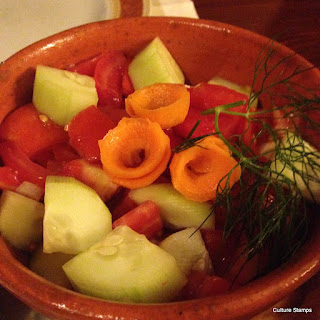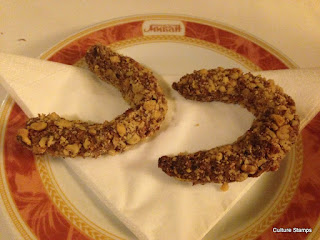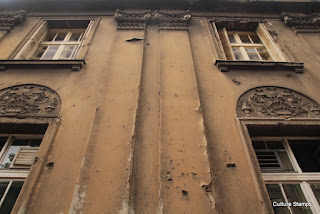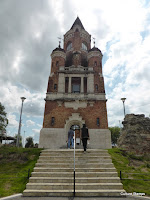 Belgrade - the capital city of Serbia, sits at the confluence of two rivers: Sava and Danube. Strategically, this location has been at the cross-roads of East and West; the site of wars between armies of the Austrian and Ottoman Empires and more recently the conflict that dominated the Balkan region during the early 1990s.
Belgrade - the capital city of Serbia, sits at the confluence of two rivers: Sava and Danube. Strategically, this location has been at the cross-roads of East and West; the site of wars between armies of the Austrian and Ottoman Empires and more recently the conflict that dominated the Balkan region during the early 1990s.Overall we were enriched by the experience and place Belgrade on our list of recommendations -full of meat eaters where English is widely spoken and easy to navigate our way around.
Day 1 - Travelling to Belgrade
At Split Airport, we waited anxiously for news of our flight to Belgrade. The Croatian Airlines plane with old fashioned propellors was sitting on the tarmac but no activity was underway to commence boarding. Eventually the PA system announced a technical fault and we took the opportunity to buy a sandwich from the terminal cafe. Then another display indicated flight cancellation - our bad luck we thought, although this would be the very first one we had experienced in all our travels to date. As the locals gesticulated at the airport staff for furthe information, we sat back and waited. However, sooner than expected everyone was smiling and the boarding call echoed over the PA - on our way to Belgrade.
Belgrade Airport to Hotel
At the Nikola Tesla Airport, we withdrew a stack of notes in the local currency - Serbian Dinar and walked to the shuttle bus terminal. Two tickets to Belgrade Central Station cost us 600 RSD (approximately 3.50 GBP) for a 25 minute journey. As we had arrived in Belgrade in the third week of August, the sun was out but we weren't suffering too extensively from the heat. It was early evening (close to 6pm) and a 20minute journey was required to our hotel door. In an attempt to take a shortcut, we decided not to stick to the 'main roads' and walked through the backroads instead - passing run-down buildings and graffiti decorated walls. The route also took us by the central park where a tent-city had been set up by refugees making their way from the Balkans to the dreams and expectations of life in Western Europe. Seeing this on TV during the news is very different to seeing it with our own eyes and it brings up a range of emotions.
Hotel for dinner
Our accommodation for the entire stay in Serbia had been booked with a family run bed and breakfast - Rooms Konak Mikan. On arrival we received a warm welcome and were shown to our rooms at the back of the building.
 |
| Front entrance to the hotel and restaurant |
Not keen on venturing out in an unfamiliar city at night, we decided to eat at the hotel restaurant as the cuisine on offer was traditional Serbian food. We didn't realise (until later when we were told by a local walking down the street) that this restaurant also had the reputation as serving one of the best traditional hamburger dishes (known as pljeskavica) in all of Belgrade. Luckily there were some examples in the mix-grill (our meals in Belgrade were all about the meat), teamed up with Serbian (srpska) salad. The portions were so large we didn't have room for dessert (although we received a complimentary cookie) and the bill was only 2,500 RSD (less than 15GBP).
 |
| Srpska salad |
 |
| Mei with the huge mixed grill |
 |
| Traditional nut cookies |
Day 2 - Exploring Belgrade
Saturday morning was a busy time for the visiting the Farmer's Market at Zeleni Venac located near the bus terminal. After walking around the stalls, we bought pastries for breakfast at a nearby cafe.
 |
| Farmer's Market |
 |
| A type of meat filled pie |
Initially when we had booked in this trip to Belgrade, we wondered how easy it would be to navigate ourselves around a city that didn't use Latin script on the road-signs. Unable to 'sound words out' - perhaps some background research into Cyrillic script might have been useful. However in the end we did not need to worry as every second person we met spoke perfect English and so helpful in assisting us with the information we needed.
Republic Square
The main square was the designated meeting point for the city walking tour. Readers of our previous blog posts will notice a pattern whereby we book ourselves into bus or walking tours as the most efficient way to see a new city. The most prominant landmark in the square is the statue of Mihailo Obrenovic, Prince of Serbia riding a horse.
 |
| Walking tour meeting point |
On the other side of the square, a large building was blocked by scaffolding - later it was revealed that this was the infamous National Museum of Serbia - closed for renovation for so long that the locals had lost hope. Recently a clock with a count-down timer had been installed to give some indication of when the museum would be reopened.
The walking tour group size was large and from memory ended up splitting into sub-groups. There are several tours that stagger their starting time, so keep an eye out for the 'correct coloured name tag or umbrella' to find the right one, or you could just select at random. Our guide (who works on a tips basis) was very informative and good at keeping the group together.
Belgrade History
As our group walked through the streets of Belgrade, the tour guide explained that the city had been razed to the ground more than 40 times due to countless wars and conflict resulting from its strategic geogaphical location - once the border line for the Roman Empire, Byzantine Empire, Kingdom of Hungary, Serbia, Ottoman Empire, Habsburg Monarchy - at times opposing armies would face each other from across the river bank near where the Great War Island is located.
Our guide showed us a building, the photo of which is below that highlights damage inflicted during World War I, II and more recently in the 1990's when Belgrade was the subject of NATO bombing. A number of buildings in the city have been left in a ruined state as a memorial of the lives lost.
Despite the ruins of damaged buildings, street artworks: paintings, murals and sculpture colour the city and we found this to be quite interesting as photo subjects.
Dinner - Manufaktura
Eating so much at lunch, we returned to our hotel to rest. We didn't venture back out until the evening, walking around the shopping district of Belgrade and passing by a tapas bar - Manufaktura (next to a laneway of red umbrellas) that had been recommended to us by our walking tour guide.
It served cured meats, wine and had live music playing.
Day 3 - Zemun
Taking a short day trip out of Belgrade, we boarded a bus from near the Farmer's Market to the historical town of Zemun. We got off the bus near the local market and walked to the river-front where we could start exploring the town.
As the weather was nice, it was good to walk around the town and visit an old tower at the top of a small hill known as Kula Sibinjanin Janka (The tower of Janos Hunyadi).
From the tower, we experienced panoramic views back to the river and the Old Town of Belgrade.
Along the riverfront we ate at a restaurant - Pectopah where we drank beer, a shot of Rakia to warm ourselves up and a grilled seafood meal.
Saint Sava Temple
Calling it quits after two long days of sightseeing in Belgrade, we took the hotel staff member's recommendation to find a quiet un-touristy restaurant up the road that served good Serbian food and beer, before wrapping up and heading for bed ourselves.
**Connect With Us**
This post was written by: Culture Stamps
If you liked this post, please share it with others using the social media buttons below.To connect with us and see snippets of our Culture Stamp travel adventures:
 |
| Count-down to museum opening |
The walking tour group size was large and from memory ended up splitting into sub-groups. There are several tours that stagger their starting time, so keep an eye out for the 'correct coloured name tag or umbrella' to find the right one, or you could just select at random. Our guide (who works on a tips basis) was very informative and good at keeping the group together.
Belgrade History
As our group walked through the streets of Belgrade, the tour guide explained that the city had been razed to the ground more than 40 times due to countless wars and conflict resulting from its strategic geogaphical location - once the border line for the Roman Empire, Byzantine Empire, Kingdom of Hungary, Serbia, Ottoman Empire, Habsburg Monarchy - at times opposing armies would face each other from across the river bank near where the Great War Island is located.
 |
| The river bank - scene of many conflicts |
 |
| Damage due to many conflicts |
Despite the ruins of damaged buildings, street artworks: paintings, murals and sculpture colour the city and we found this to be quite interesting as photo subjects.
Skadarlija (Skadarska street)
One of the memorable stops along the walking tour was Skadarlija street - a cobblestone area full of restaurants and bars.
One of the memorable stops along the walking tour was Skadarlija street - a cobblestone area full of restaurants and bars.
It was during this stop that our guide gave out samples of plum rakia and divulged the fact that Serbia is the 2nd ranked country in the world for plum production - with so many that the excess are turned into brandy.
Kalemegdan - Belgrade Fortress
One of Belgrade's most significant landmarks is the Fortress. Located on a ridge overlooking the Sava and Danube Rivers, it was the site of the first Celtic settlement and population in Belgrade. Later it was occupied by the Romans as a military outpost - Singidunum; and in the 6th century rebuilt by Byzantine Emperor Justinian I. The following centuries involved conflicts between Slavic tribes, Hungarians and Ottomans.
 |
| King's Gate |
Whilst we were enjoying the view from the fortress walls, our guide handed out copies of the banknotes that existed during the years of hyperinflation in Yugoslavia. We had seen similar notes during our walking tours in Slovenia and Croatia; but it was poignant to hear our guide talk about her families' experience at trying to buy a cup of coffee during those times.
 |
| Copy of a trillion dollar note |
Pobednik (The Victor) monument
Close by the Fortress is the Victor monument - a tribute to victory during times of war. The monument overlooks the river where splav bars (on rafts) are lined up along the banks.
 |
| Victor monument |
 |
| Bars along the riverbank |
Lunch - Skadarska street
We returned to Skadarska street to find something to eat, walking into a restaurant that appeared popular and had friendly English speaking staff. We drank the local beer (Jelen), ate sausages and a version of the hamburger pljeskavica covered in a butter ball - that melted into the most calorific but tasty sauce.
Dinner - Manufaktura
Eating so much at lunch, we returned to our hotel to rest. We didn't venture back out until the evening, walking around the shopping district of Belgrade and passing by a tapas bar - Manufaktura (next to a laneway of red umbrellas) that had been recommended to us by our walking tour guide.
It served cured meats, wine and had live music playing.
Taking a short day trip out of Belgrade, we boarded a bus from near the Farmer's Market to the historical town of Zemun. We got off the bus near the local market and walked to the river-front where we could start exploring the town.
 |
| Following the cobblestones up a hill |
From the tower, we experienced panoramic views back to the river and the Old Town of Belgrade.
 |
| Views towards Belgrade |
Along the riverfront we ate at a restaurant - Pectopah where we drank beer, a shot of Rakia to warm ourselves up and a grilled seafood meal.
After lunch we walked back to the bus stop, passing by a small market in the square where we bought a small bag of blue plums to try this famous export. But we over-purchased, endeding up with so many that we had to throw it away before we finished
 |
| Plums |
Saint Sava Temple
Catching a bus back to Belgrade's central bus station, we walked for about 30minutes down the main road to visit the Saint Sava Temple - one of the biggest Orthodox churches in the world but still unfinished due to work being halted due to regional conflicts.
 |
| Saint Sava Temple |
 |
| Beer time again |
 |
| Last pljeskavica for the trip |
Next blog post:
Budva and Kotor, Montenegro
**Connect With Us**
This post was written by: Culture Stamps
If you liked this post, please share it with others using the social media buttons below.To connect with us and see snippets of our Culture Stamp travel adventures:
- Follow Culture Stamps on Twitter
- Follow us on Bloglovin Follow my blog with Bloglovin
- LIKE our Culture Stamps Page on Facebook




































No comments:
Post a Comment